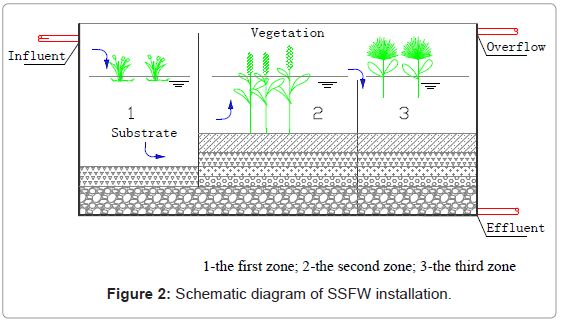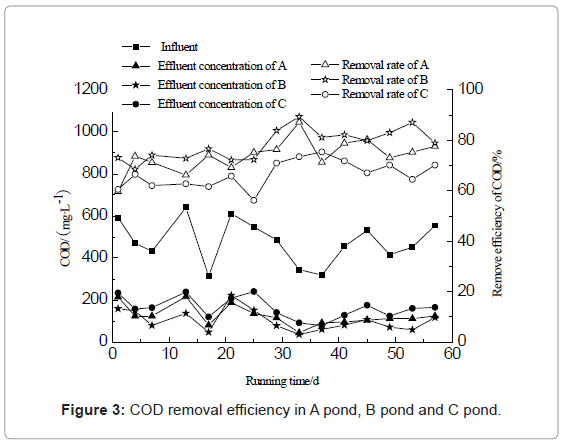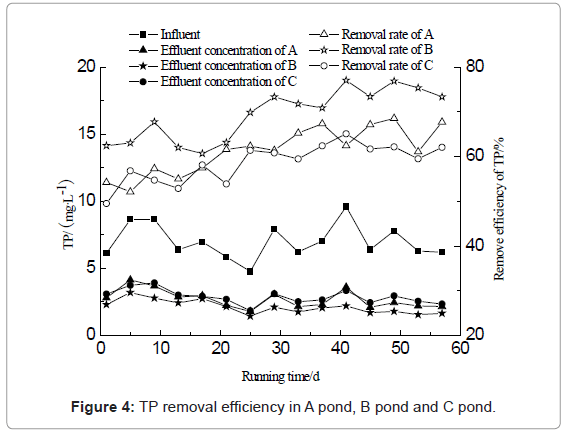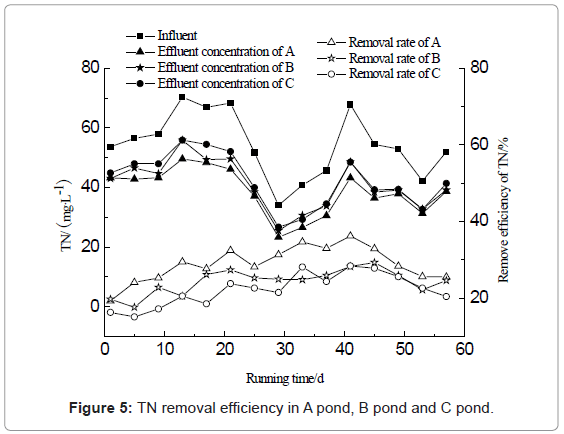Research Article Open Access
Study on Different Substrates in Stable Surface Flow Wetland
Chengduan Wang1 and Jun Zhang2*
1Sichuan University of Science and Engineering, Zi gong, Sichuan, 643000, China
2School of Environment and Resources Southwest University of Science and Technology, Mian yang, Sichuan 621010, China
- *Corresponding Author:
- Jun Zhang
School of Environment and Resources
Southwest University of Science and Technology
Mian yang, Sichuan 621010, China
E-mail: zj-qhd@163.com
Received Date: January 11, 2012; Accepted Date: April 12, 2012; Published Date: April 21, 2012
Citation: Wang C, Zhang J (2012) Study on Different Substrates in Stable Surface Flow Wetland. J Ecosyst Ecogr 2:109. doi:10.4172/2157-7625.1000109
Copyright: © 2012 Wang C, et al. This is an open-access article distributed under the terms of the Creative Commons Attribution License, which permits unrestricted use, distribution, and reproduction in any medium, provided the original author and and source are credited.
Visit for more related articles at Journal of Ecosystem & Ecography
Abstract
This paper discussed the feasibility and advantage of the removal efficiency of low concentration sewage using three Stable Surface Flow Wetlands (SSFW) with bamboo splint and palm silk as substrates. Under the same hydraulic loading, the result of experiment indicated that the removal rate of COD,TP, TN were 73.97%, 61.42%, 28.98% respectively in SSFW with a bamboo splint substrate, and the corresponding removal rate of SSFW with a palm silk substrate were 78.37%, 69.42%, 24.4%; while substrate without a bamboo splint and a palm silk were 66.61%, 58.71%, 22.23%. The above information demonstrates that the removal efficiency of TN with a bamboo splint is better while the removal efficiency of COD and TP with palm silk is better. Bamboo splint and palm silk have their own advantages when they are applied to SSFW as substrate, which provide theoretical basis for the selection and matching of substrate.
Keywords
Stable surface flow wetland (SSFW); Bamboo splint; Palm silk; Substrate; Constructed wetland
Introduction
The Stable Surface Flow Wetland (SSFW), which provides the potential of benefits such as the stable operation, the small system clogging, and the superior quality effluents [1], is a constructed wetland technology on the basis of stabilization ponds and constructed wetlands. SSFW extends the flow path and increases the hydraulic retention time. Pollutants can fully contact with substrates, and plants also fully contact with microbes, which make the physical, chemical and biological reactions more fully in the wetland. Meanwhile by adding the baffle to make the direction of flow in wetland bed run up and down alternately, the fluid state was more uniform, and the dead area was reduced to appear [2].
Substrate can not only provide carriers for the growth of plants and microbes, but it also removes pollutants directly by its sedimentation, filtration, and adsorption and so on. A large number of researches from home and abroad explored the purification of the constructed wetland by choosing of substrates and plant species and the planting conditions such as the size of the wetland bed, the breadth proportion, water operating conditions and temperature and so on [3-5]. This paper studied the removal effect of the SSFW to pollutants with different substrates with the purpose of finding a scientific and efficient substrate. An appropriate constructed wetland substrate plays a vital role in optimizing the sewage treatment technology of the constructed wetland.
At present there are only a few researches using the bamboo splint and palm silk as the constructed wetland substrates. As an excellent biological carrier, the surface of the bamboo splint contains mass of hydroxyl, making it hangs the membrane rapidly under the conditions of oligotrophic, low temperature and so on [6]. While the palm silk has a large area of surface, contains no sugar but more than 70% of cellulose, and are not liable to rotten due to insect bites. And they have strong water resistance, great intensity, and will not become fragile. As natural substrates, bamboo splint and palm silk have many good potential features as potential wetland substrates because of the advantages such as being produced simply, no toxic effects on microorganism, low cost, planting in a wide range and easy to access in the south.
Technological Designs
The raw wastewater source and characteristics
The experimental sewage was obtained from the effluent coming from the fine grid in the Sewage Treatment Plant, which process 10,000 tons sewage a day in Southwest University of Science and technology. The scope of the sewage quality indicators was shown in Table 1.
| Water quality indicators | COD(mg/L) | TN(mg/L) | TP(mg/L) | pH |
| Range | 300-1500 | 30-70 | 4-10 | 7-8 |
Table 1: Inflow water quality of constructed wetlands
Technological process
Raw water can convert the large molecules of organic compounds into small ones when enter into the anaerobic tank, which can enhance the biodegradability of sewage. The water in the anaerobic tank flows into the reservoir automatically through the overflowing, and the dissolved oxygen in water can increase over 1mg/L by water-dropping aeration. Then it came into SSFW and purified the water by the substrate adsorption and filtration, plant absorption and microorganism’s role of the degeneration and so on. The experiment uses three parallel SSFW treating devices and numbers are A, B and C separately. A SSFW with the bamboo splint substrate was placed into the pond A, and a SSFW with the palm silk substrate was placed into the pond B; the pond C contains a SSFW without the bamboo splint substrate or palm silk substrate (Figure 1).
The main building and design parameters
The anaerobic tank was made of semi-buried reinforces concrete with dimensions of 1.0m × 1.0m × 1.8m (length × width × height) , the bottom elevation of -0.5m, the top elevation of 1.3m, the extra high of 0.3m. Because of Flowing into the reservoir through the overflow, anaerobic tank and the reservoir is designed to share the same wall height 1m. The above was covered with the glass plate, HRT=2d. The sludge in the anaerobic tank should be cleaned by hand regularly. The reservoir was made of reinforced concrete with dimensions of 0.5m × 1.0m ×1.3m (length × width × height), the extra high of 0.3m. SSFW was made of reinforces concrete with dimensions of 2.0m × 0.5m ×1.0m (length × width × height), the bottom slope of 1% and the extra high of 0.3m. In SSFW there are two glasses fiber reinforces plastic plates. It is about 0.7m and divides the SSFW into three functional zones. The lengths of them are 0.6m, 0.8m and 0.6m separately. The total thickness of substrate laid in the first zone is 25cm. From bottom to top are 15cm gravel and 10cm sand. Water hyacinth was planted in the first zone at a density of 25 plants·m-2.The substrate in the second zone is the same as the third one. The total thickness is 40cm. The substrates from top to bottom are as follows: pond A was filled with gravel for 15cm, cinder 5cm, ceramist 5cm, sand 10cm and bamboo splint 10cm; pond B was filled with gravel for 15cm, cinder 5cm, ceramist 5cm, sand 5cm and palm silk 10cm; pond C was filled with gravel for 15cm, cinder 5cm, ceramist 5cm and sand 5cm. The Cyprus alternifolius and Rumer pationtia L were planted in the second zone and third zone respectively at a density of 15 plant·m-2. And some uniform holes should be dig on the pipe of influent and effluent in order to make the distribution and catchments uniform (Figure 2).
Experimental operation
The SSFW system began to operate after the substrate was laid and vegetation was planted in late March 2011. System used intermittent water and sludge of anaerobic in the wastewater treatment plant was added to the anaerobic tank to enhance the system’s resilience. After a week of acclimation, SSFW substrate table attached biofilm and the system enter the normal operation phase. The system was controlled by the PLC controller. Wastewater was fed from 9:00 to 18:30 every day. The total inflow is 0.65m3 every day and the Hydraulic Loading Rate (HLR) were 0.4m3/ (m2·d). Three parallel processing units were sampled every four days. Then the water quality of influent and effluent should be monitored at the same time so that we can compare the treatment effect with each other. The temperature range was 3~17°C during the experiments.
Analytical methods and data analysis
Samples including Chemical Oxygen Demand (COD), Total Phosphorus (TP) and Total Nitrogen (TN) were analyzed in accordance with Standard Methods of State Environmental Protection of China [8] The TN was determined by alkaline potassium per sulfate digestion- UV spectrophotometer method. The COD was measured by potassium dichromate oxidation. The TP was measured by ammonium molybdate spectrophotometer method. Temperature and the pH were measured with a HI223 pH-meter (Hanna Co. Italy). The data were entered into a Microsoft Excel spreadsheet. Figures were analyzed by OriginPro8.
Results and Discussion
The experiment joins the blank contrast system. Figure 3-5 show that SSFWs have a good elimination effect to the pollutant when the bamboo splint and the palm silk substrate are in the experimental operation’s process.
COD removal efficiency and analysis
The average influent concentration was 477.88 mg/L by analyzing the COD removal rate of the A, B and C pond in Figure 3. The quality of B pool with the palm silk substrate achieved remarkable results for COD removal in the sewage. The average COD effluent concentration was 106.4 mg/L. While the average effluent COD concentration of A pool with bamboo silk and blank C pool were 125.46 mg/L and 161.82 mg/L respectively. The effects were not better than the above. The corresponding removal rate was 78.37%, 73.97% and 66.61%. Palm silk had some advantages for the treatment of low concentration of COD in the effluent because it contains 70% of cellulose and cellulose which can degrade in the course of soluble carbon sugar that provides carbon source for bacterial metabolism. The early experiment had good removal efficiency on COD, but after a period of operation, organic matter concentrated in the substrate surface, leading to the treatment effect in the latter part of the experiment had some fluctuations in COD. Sewage had been pre-treatment in anaerobic tank before it entered into SSFW, making the majority of organic molecules into small molecules and enhancing the biodegradability of sewage, which provides a guarantee for the follow-up COD removal.
TP removal efficiency and analysis
It can be seen from Figure 4 that the TP removal rate of A, B and C pools are gradually rising. In the early of experiment, the rising curve is steep. It’s because the gradually establishment of biofilm in SSFW system and the enhancement of microbial degradation. In the latter of experiment, gentle curves and eventually tend to equilibrium. Researchers have shown that 70% ~ 87% of the phosphorus in constructed wetland are removed by adsorption and precipitation of substrate [8]. Substrate composition and its physical and chemical properties have a significant effect on the purification of phosphorus. The bamboo splint and the palm silk used in the experiment are natural materials. Figure 4 shows that pool B of SSFW with palm silk substrate has higher TP adsorption capacity than that of pool A of SSFW with bamboo splint substrate and C pool of SSFW with blank. The average effluent of TP concentration were 2.12mg/L, 2.7mg/L and 2.89mg/L, and the corresponding average removal rate of 69.42%, 61.42% and 58.71% separately. The palm silk substrate has obvious advantages for the adsorption of TP compared to the bamboo splint substrate. The palm silk substrate is more slender than the bamboo splint substrate. And on the same volume conditions, the palm silk have much larger surface area than the bamboo splint, making the palm silk on the sewage with a good adsorption performance. That is one of the important reasons why the palm silk performance better than the bamboo splint and the blank on the removal of phosphorus. Alkaline environment is more suitable for the growth of phosphorus than that of the acidic environment. By monitoring three SSFW systems, the pH was about 7.1~7.8, which is also conducive to the removal of phosphorus.
TN removal efficiency and analysis
It can be seen from Figure 5 that the pool A, B and C have some superiority on TN compared to the common constructed wetland. The way in which the sewage enters the SSFWs is uniform distribution and the water inlet is higher than the water surface, which has the function of water-dropping aeration and enhanced the TN elimination effect of SSFWs. People have studied that the ammonia volatility of purification way can be neglected when pH value of the sewage in the constructed wetland is less than 8 [9]. In this experiment, the pH value of SSFWs interior environment was between 7~8. Most of the other purification ways of TN were the nitration and the denitrification except the substrate absorption and the plant absorption of TN. The nitrification carried on under the good oxygen condition. And it runs smoothly because of the oxygenizement of the plant root system and atmospheric reaeration of free surface in the SSFWs. The bamboo splint substrate and the palm silk substrate were the disorderly stack in the SSFWs. The different crevice of them can intercept and fix suspension in the sewage so as to form a large number of suspended substances. These can fix nitrifying bacteria and enhance the nitration effect. The denitrification was one of the efficient ways to discharge the nitrogen. The concentrations of TN in the effluent were relatively low because the denitrification carried on under the anaerobic condition and the anaerobic environment space is relatively big and the denitrification is quite complete at the depth 0.7m of SSFW. This also shows that the denitrification mainly occurs at bottom of the SSFW.
Figure 5 also shows that the average effluent concentration of TN in A, B and C pools was 38.6mg/L, 41.07mg/L and 42.33mg/L respectively, and the corresponding average removal rate was 28.98%, 24.4% and 22.23%. The removal rate of TN in pool A was higher than that of B and C. The bamboo splint substrate surface area is rougher than the palm silk substrate. And it had developed porosity internal and better ventilation. It not only made oxygen in the atmosphere enter into the SSFWs, but it also promoted the formation of anaerobic environment to remove nitrogen for denitrification because of the high moisture content. The substrate with bigger porosity can provide microbial with more surface area to grow for the SSFW system, so microbial biomass was larger and community structure was more stable. Thus purification would be more efficiency and stable. In the later experiment, TN removal rate declined and the concentration of the effluent TN was high. There are two reasons for it. On one hand, denitrification was not fully and the productions accumulated continuously for the strong nitrification; On the other hand, when it came to mid-May, the Rumer pationtia L plants began to wither and leaves in the sewage released a certain amount of nitrogen.
Conclusions
(1) Both the bamboo splint and palm silk substrates are natural materials. They are widely planted and easily obtained in the Sichuan province. They are cheap and do no harm to the environment. They can easily make up for the secondary pollution caused by the other substrates shortages as SSFW substrates.
(2) The advantages of bamboo splint substrate are porosity larger and higher moisture content. While the palm silk have a large area of surface, contains no sugar but more than 70% of cellulose, and are not liable to insect. And they have strong water resistance, great intensity, and will not become fragile.
(3) Bamboo splint and palm silk have their own advantages when they are applied to the treatment of low strength domestic sewage in SSFW as substrates. The removal efficiency of TN with a bamboo splint is better while the removal efficiency of COD and TP with palm silk is better.
Acknowledgements
This paper was funded by the key Science Project (2011G009) of Zigong, Sichuan Province of PRC. The authors would like to thank the Project.
References
- Chengduan Wang (2008) Low-cost wastewater treatment course [M]. Beijing: Chemical Industry Press.
- Jing-xi Tie, Zhi-hong Zheng, Zheng Zheng, Luo Xingzhang (2009) Study on the characteristics of three sub-surface flow constructed wetlands with different internal structures. Industrial Water Treatment 29: 51-53.
- Gearheat RA (1992) Use of constructed wetland to treat domestic wastewater, city of Arcat California. Water Science & Technology 26: 1625-1637.
- Zhang HC (2004)Study progress in constructed wetland ecosystems for sewage purification. Techniques and Equipment for Environmental Pollution Control 5: 11-14.
- Kong LY, Ni JR (2007) Characteristics of the generalized structure of pollutant removal models for constructed wetlands. Acta Ecologica Sinica 27: 1428-1433.
- Liu Ying, Lingling Wang (2003-2007) A way of carrier substrate and preparation [P].
- State Environmental Protection of China (2002) Testing and Analysis Method for Water and Wastewater (4th Edition) [M]. Beijing: China Environmental Science Press : 252-354.
- Reddy KR, Connor GA, Gale PM (1998) Phosphorus sorption capacities of wetland soils and stream sediments impacted by dairy effluent. Journal of Environmental Quality 27: 438-447.
- Koottatep T (1997) Role of plant uptake on nitrogen removal in constructed wetlands located in the tropics. Water Sci Technol 36: 1-8.
Relevant Topics
- Aquatic Ecosystems
- Biodiversity
- Conservation Biology
- Coral Reef Ecology
- Distribution Aggregation
- Ecology and Migration of Animal
- Ecosystem Service
- Ecosystem-Level Measuring
- Endangered Species
- Environmental Tourism
- Forest Biome
- Lake Circulation
- Leaf Morphology
- Marine Conservation
- Marine Ecosystems
- Phytoplankton Abundance
- Population Dyanamics
- Semiarid Ecosystem Soil Properties
- Spatial Distribution
- Species Composition
- Species Rarity
- Sustainability Dynamics
- Sustainable Forest Management
- Tropical Aquaculture
- Tropical Ecosystems
Recommended Journals
Article Tools
Article Usage
- Total views: 14905
- [From(publication date):
April-2012 - Dec 22, 2025] - Breakdown by view type
- HTML page views : 10123
- PDF downloads : 4782





